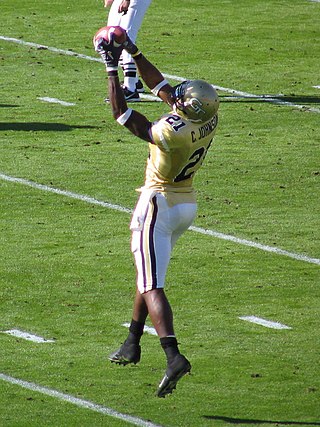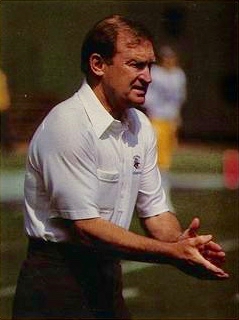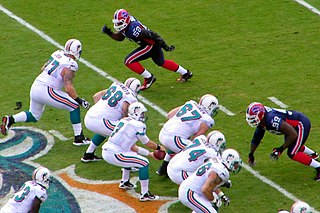
A wide receiver (WR), also referred to as a wideout, and historically known as a split end (SE) or flanker (FL), is an eligible receiver in gridiron football. A key skill position of the offense, WR gets its name from the player being split out "wide", farthest away from the rest of the offensive formation.

The tight end (TE) is an offensive position in American football, arena football, and Canadian football. It is a hybrid that combines the characteristics and roles of both an offensive lineman and a receiver. As part of the receiver corps, they play inside the flanks (tight), contrasted with the split end who plays outside the flanks (wide). Like offensive linemen, they are usually lined up on the offensive line and are large enough to be effective blockers. On the other hand, unlike offensive linemen, they are eligible receivers and potent weapons in a team's offensive schemes. A good tight end is designed to be a mismatch in one of two ways- due to their larger size to a regular receiver an opposing team may allocate a defensive lineman to block a tight end for run plays, but that lineman would be unable to keep up with a tight end on a passing play. Conversely, an opposing team may allocate a smaller and faster safety or cornerback to guard a tight end in case of a pass play, but then that safety will be in danger of being overpowered by the tight end in a run play.
Strategy is a major part of American football.
American football positions have slowly evolved over the history of the sport. From its origins in early rugby football to the modern game, the names and roles of various positions have changed greatly, some positions no longer exist, and others have been created to fill new roles.
A formation in American football refers to the position players line up in before the start of a down. There are both offensive and defensive formations and there are many formations in both categories. Sometimes, formations are referred to as packages.

A sweep is an outside running play in American football where a running back takes a pitch or handoff from the quarterback and starts running parallel to the line of scrimmage, allowing for the offensive linemen and fullback to get in front of him to block defenders before he turns upfield. The play is run farther outside than an off tackle play. Variants of the sweep involve the quarterback or a wide receiver running with the ball, rather than a running back. When a wide receiver runs with the ball, it is known as a jet sweep.
An H-back is an offensive position in American football. The H-back lines up similarly to a tight end, but is "set back" from the line of scrimmage, and is thus counted as one of the four "backs" in the offensive formation. The H-back, while similar in name, should not be confused with "halfback" or "running back", which are used to denote a separate, primary ball-carrying backfield position. The position was made notable in the National Football League (NFL) by the Washington Redskins under head coach Joe Gibbs, who ran a two tight end system. The position was named F-back when used later in Norv Turner's offensive system. The position is similar to that of a slotback

Single set back is an offensive base formation in American football which requires only one running back lined up about five yards behind the quarterback. There are many variations on single back formations including two tight ends and two wide receivers, one tight end/three wide receivers, etc. The running back can line up directly behind the quarterback or offset either the weak side or the strong side.

In American football, a T formation is a formation used by the offensive team in which three running backs line up in a row about five yards behind the quarterback, forming the shape of a "T".

A halfback (HB) is an offensive position in American football, whose duties involve lining up in the offensive backfield and carrying the ball on most rushing plays, i.e. a running back. When the principal ball carrier lines up deep in the backfield, and especially when that player is placed behind another player (usually a blocking back), as in the I formation, that player is instead referred to as a tailback (TB).

In American football, the specific role that a player takes on the field is referred to as their "position". Under the modern rules of American football, both teams are allowed 11 players on the field at one time and have "unlimited free substitutions", meaning that they may change any number of players during any "dead ball" situation. This has resulted in the development of three task-specific "platoons" of players within any single team: the offense, the defense, and "special teams". Within these three separate "platoons", various positions exist depending on the jobs that the players are doing.

The triple option is an American football play used to offer six ways to move the football forward on the field of play. The triple option is based on the option run, but uses three players who might run with the ball instead of the two used in a standard option run.

A fullback (FB) is a position in the offensive backfield in gridiron football and is one of the two running back positions along with the halfback. Fullbacks are typically larger than halfbacks, and, in most offensive schemes, the fullback's duties are split among power running, pass catching, and blocking for both the quarterback and the other running back.

In American football, Air Coryell is the offensive scheme and philosophy developed by former San Diego Chargers coach Don Coryell. The offensive philosophy has been also called the "Coryell offense" or the "vertical offense".

A pro-style offense in American football is any offensive scheme that resembles those predominantly used at the professional level of play in the National Football League (NFL), in contrast to those typically used at the collegiate or high school level. Pro-style offenses are fairly common at top-quality colleges but much less used at the high school level. The term should not be confused with a pro set, which is a specific formation that is used by some offenses at the professional level.
The following terms are used in American football, both conventional and indoor. Some of these terms are also in use in Canadian football; for a list of terms unique to that code, see Glossary of Canadian football.

Buck-lateral is an American football play or a series of plays used in the Single-wing formation. Since the Single-Wing formation lost prominence by 1950, the football play referred to as the buck-lateral is almost gone from football's vocabulary. However, prior to this time, the buck-lateral play gave fullbacks the option to run, lateral, or hand off the ball to another player. Running the buck-lateral required an offensive scheme that needed the fullback to possess many specialized skills, as opposed to today's fullback who mainly blocks and carries the ball infrequently.
In American football, a back is a player who plays off of the line of scrimmage. Historically, the term "back" was used to describe multiple positions on offense and defense, although more descriptive and specific position naming is now common. Thus, "back" can refer to positions including:
A play calling system in American football is the specific language and methods used to call offensive plays.















